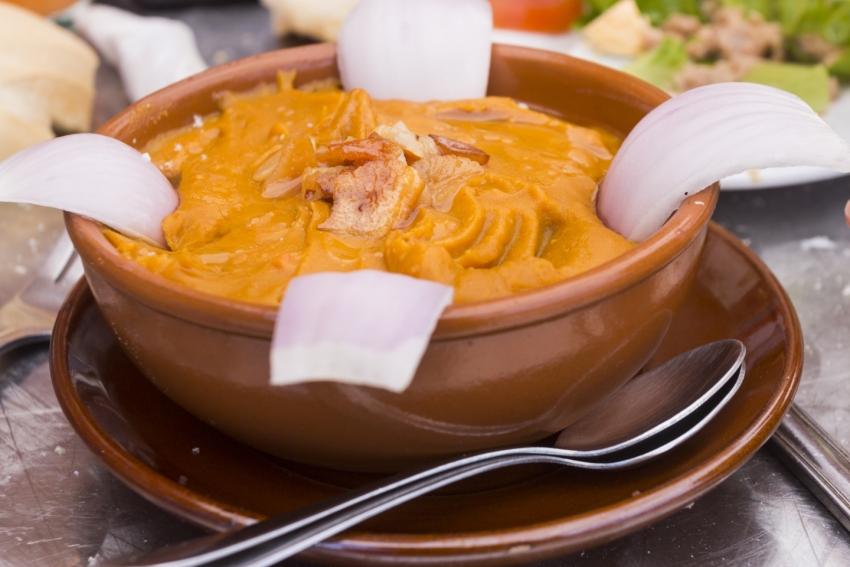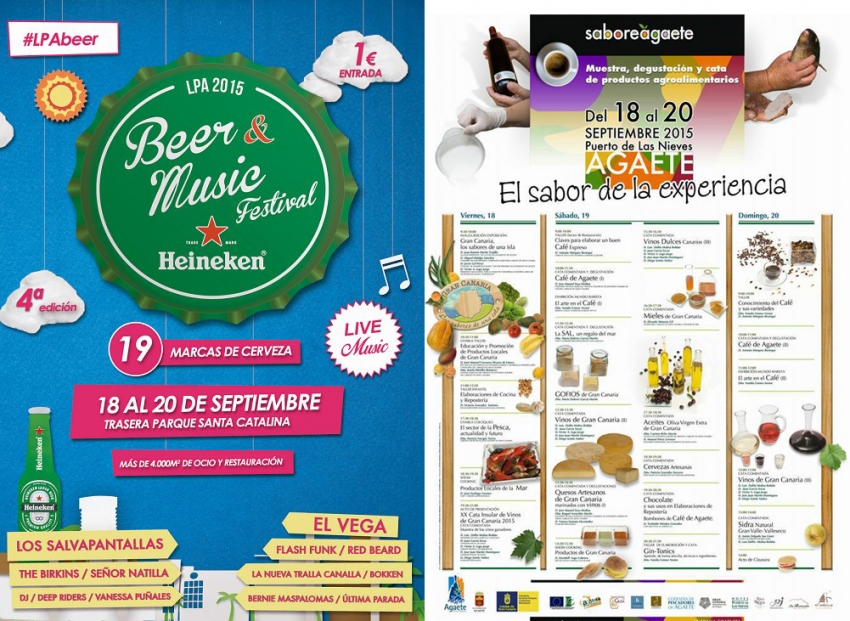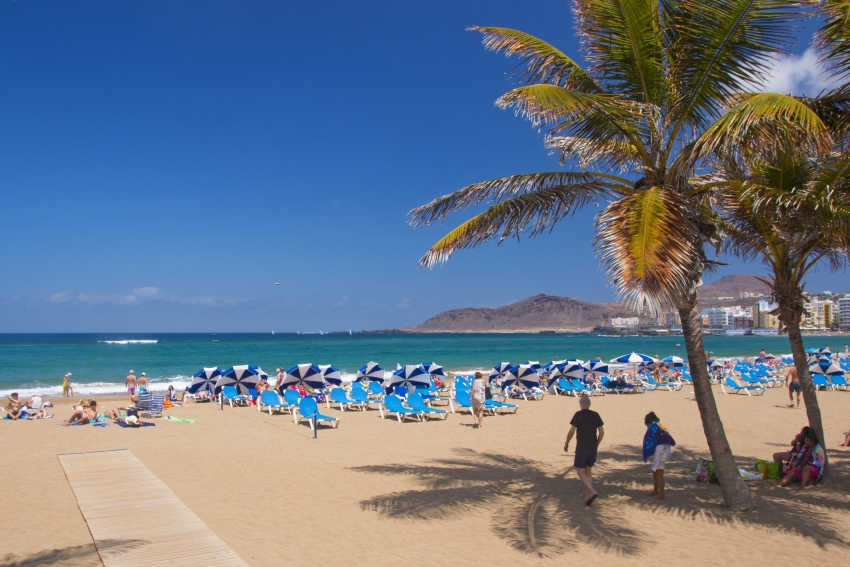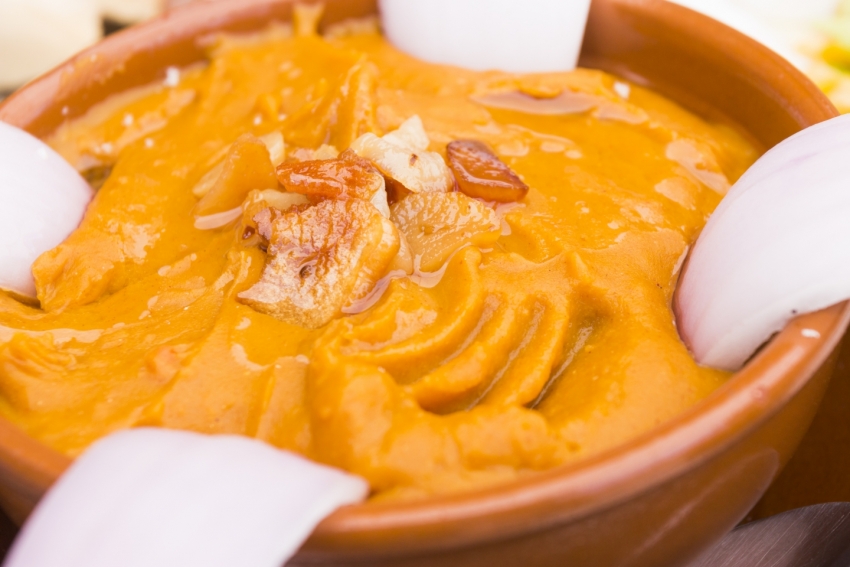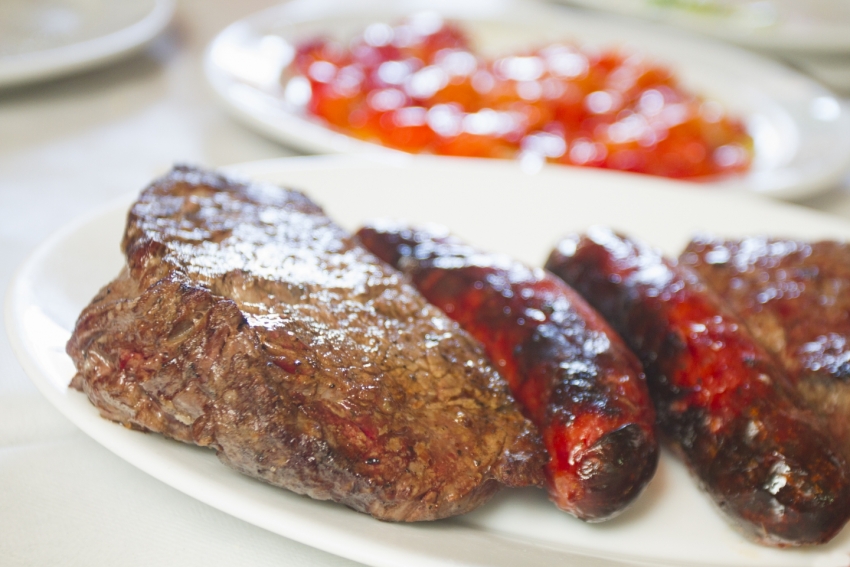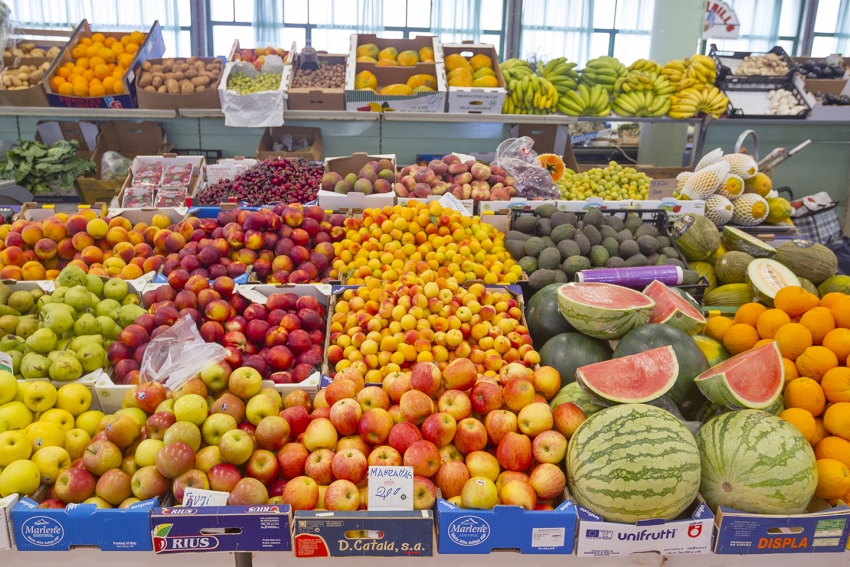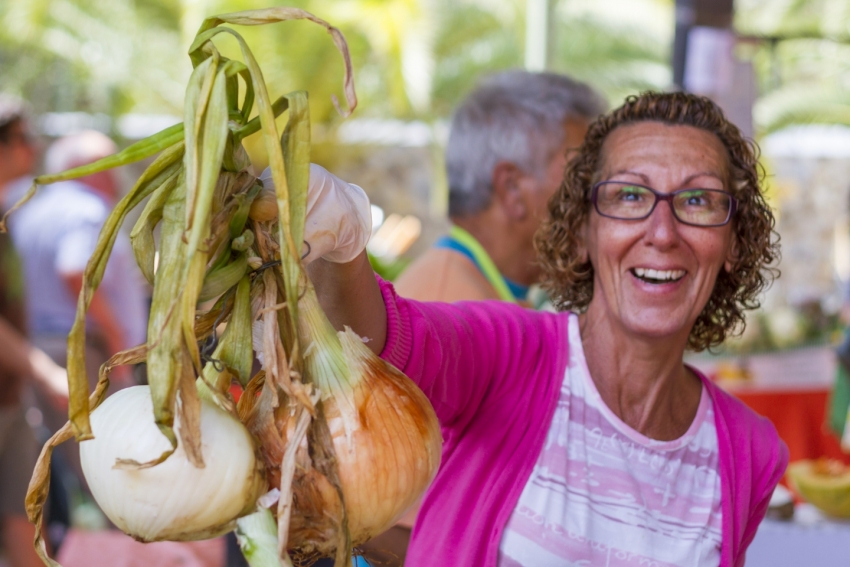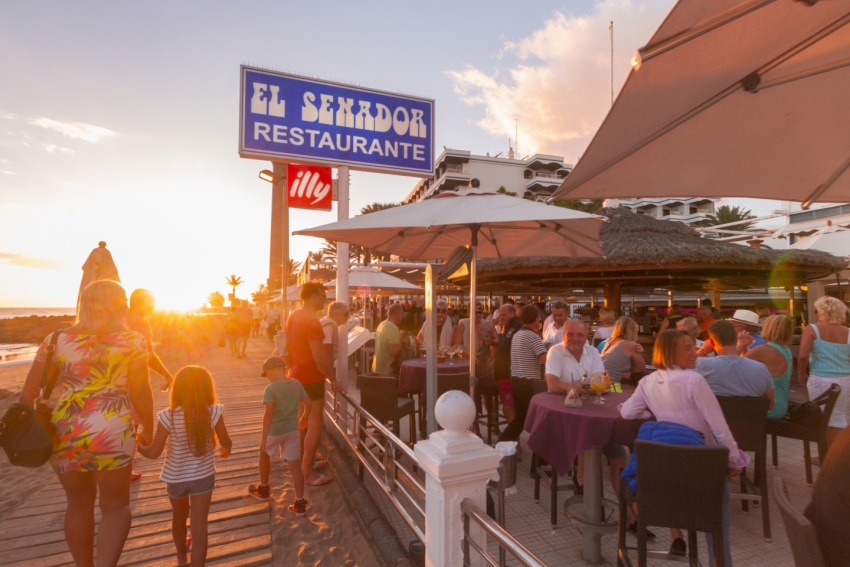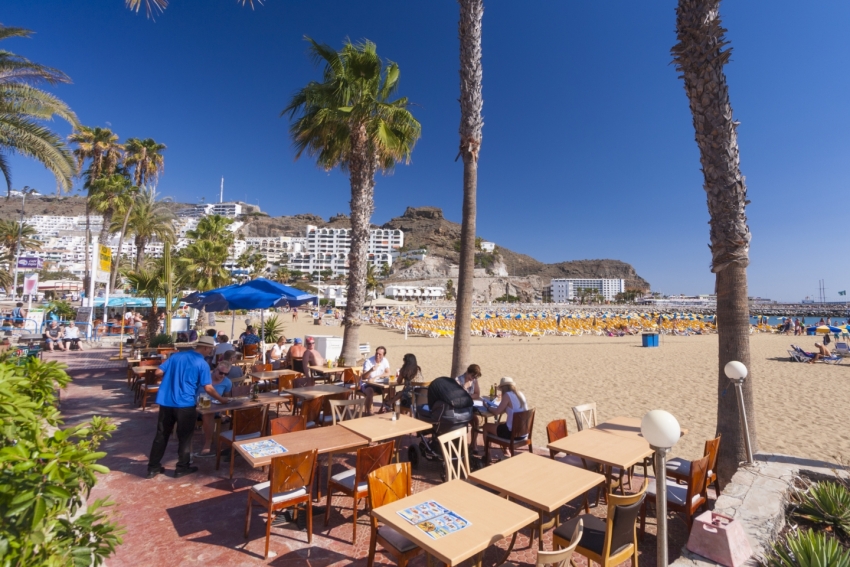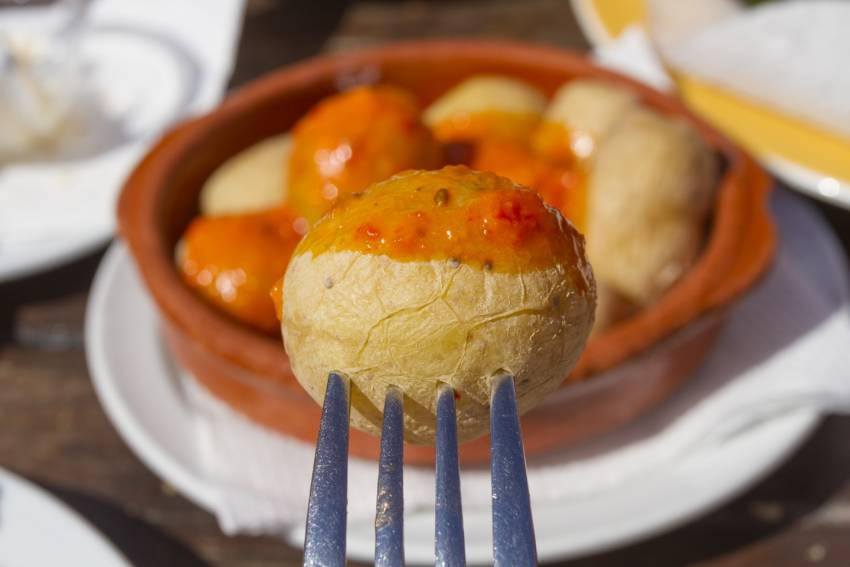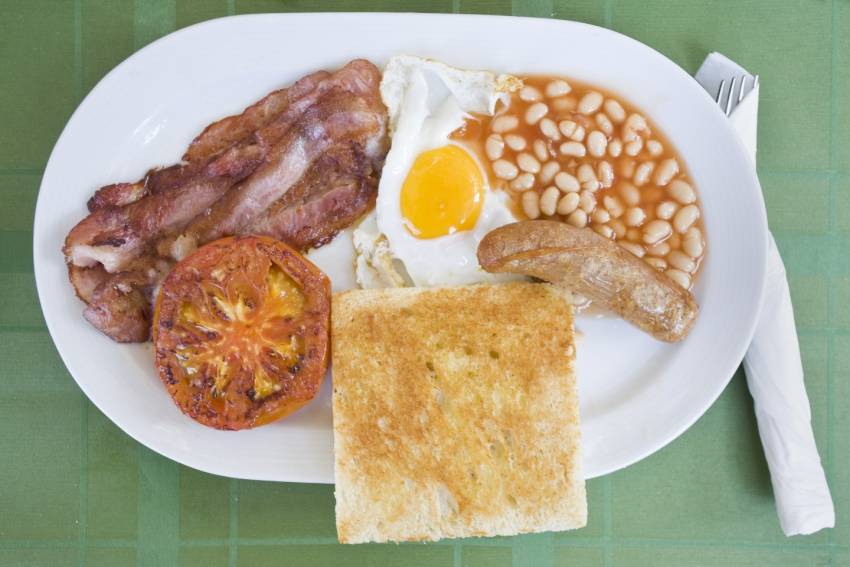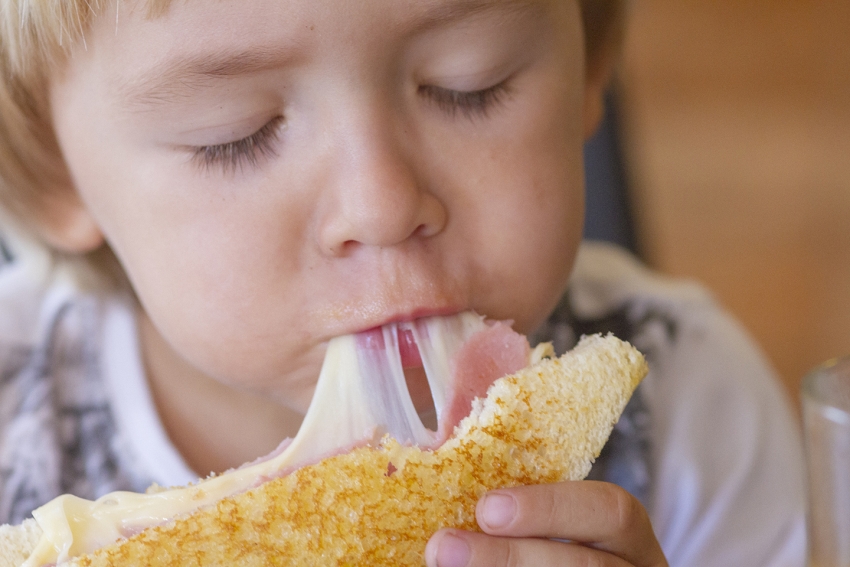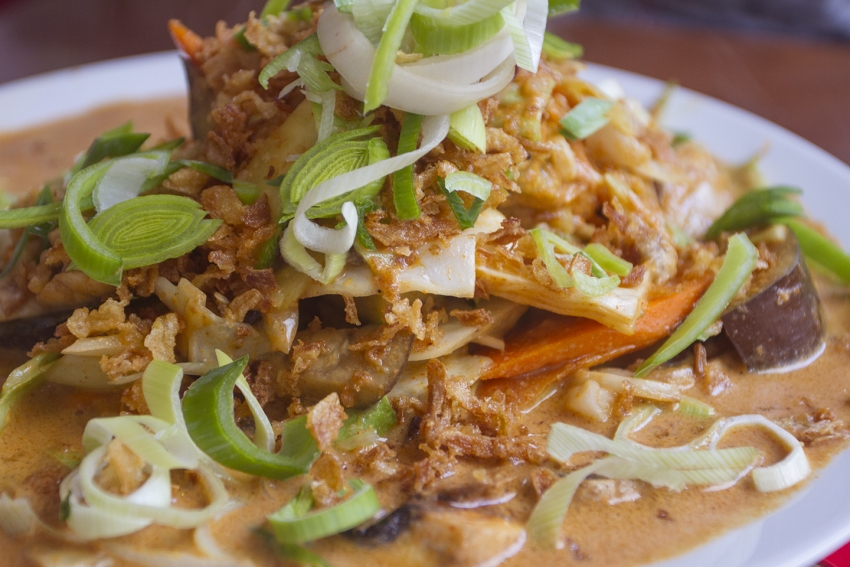Beachfront Tapas In Las Palmas: Toma Pan y Moja
Tapas are not a traditional thing in Gran Canaria. You don't get the free tapa with every beer that is so common in Mainland Spain, except on Tapas nights.
That said, there are places that offer something similar to the tapas experience in the capital Las Palmas.
Toma Pan y Moja, on ther beachfront at the southern tip of Playa Chica, is one of the best.
It has sunset views, outdoor tables (the ones furthest from the door get less breeze) for hot days and a cosy interior for those cooler winter evenings.
The papas con mojo with heirloom black Canary Islands potatoes are delicious (summer season only). The cold tomato soup (salmorejo) is very tasty, the croquetas excellent and the ham is decent quality. Try the tortilla española with avocado if you dare!
With friendly service, generous portions and fair prices, Toma Pan y Moja is always a good bet for a snack on the Las Canteras beachfront.
Eat The World: 20 Of The Best National Cuisine Restaurants In Las Palmas
In Las Palmas, you can eat the world with cuisines from over 50 countries on offer. Here are 20 of our favourites national restaurants.
Gofio: The History & Origins Of An Ancient Canary Islands Food
Papas con mojo are the most famous Canarian dish, but gofio flour is the food that Canarians think of as their own. But rather than a unique Canary Islands food, gofio is a link between the islands and places all over the world.
Two Great Gran Canaria Food Events This Weekend
Gran Canaria hosts two separate food-and-drink events this weekend. One in Santa Catalina Square in Las Palmas, the other at Puerto de las Nieves in the north-west.
Three Great Places To Get Pizza By Las Canteras Beach
Whether you eat it at a beachfront restaurant or carry it onto the sand, pizza is perfect beach food. Here are three top spots to get pizza by the beach in Las Palmas.
It's Official: Gofio Is Good For You:
Top 10 Things You Have To Eat In Gran Canaria That Aren't Papas Con Mojo
Everybody loves a plate of papas con mojo, but there's more to Gran Canaria food than salty potatoes. From great steak to cactus fruit, here's ten things that have to try before you leave.
San Mateo's Massive Weekend Market
It's in a warehouse and you can't call it pretty but San Mateo market sells the widest range of local produce available anywhere in Gran Canaria.
Food Shop Like A Local In Las Palmas
Las Palmas is full of supermarkets, but which chain is best, and where do you go for the fresh stuff and the exotic stuff? Here's how to do your food shopping like a local in Las Palmas de Gran Canaria.
The Eight Types of Gran Canaria Restaurant
You find them in caves, hanging out over the sea and clustered together in shopping centres but most Gran Canaria restaurants belong to one of these eight kinds.
Eating Out at Puerto Rico in Gran Canaria
Most of the restaurants in Puerto Rico resort are in the colossal shopping centre but there are options by the marinas and the beach, and good spots for dinner tucked away amongst the apartments.
Seven Reason Why Canary Islands Mojo Sauce Is Good For You
Canarian mojo sauce tastes great and is made with fresh, healthy ingredients. Here're seven reasons why you should eat as much mojo sauce as possible in the Canary Islands.
Delicious Daily Doughnuts in Gran Canaria
Light and fluffy, golden brown, with a crust of flaky sugar and a hint of lemon: Gran Canaria's doughnuts, called donuts, are a delight.
Top Six Scary Gran Canaria Seafood Dishes
Canarian food is famous for its simple, tasty seafood like fried squid rings, delicious prawns and fish stew. However, delve a bit deeper into the local cuisine and some more exotic ocean ingredients and seafood dishes pop up.
Alex Says: 25 years ago I remember watching old women in Lanzarote, wearing huge hats and head scarves, munch their way through a whole bucket of live sea urchins or erizos de mar. The cracked each one open and sucked out the fresh roe, before baiting their fish traps with the shells. The fresh roe is soft and a bit slimy, but tastes fresh and slightly fishy. In Japan, it is highly prized for top quality sushi.
Live Sea Urchins
Sea urchins have become such a problem in parts of the Canaries that the government is trying to get Canarians to eat them more often. The roe, cooked down into a sauce, tastes intensely of the sea. Trouble is, you need to collect a lot of spiny urchins to make a plate of pasta! Each one gives you half a teaspoon of eggs.
Grilled Limpets
Another local speciality is grilled limpets or lapas, served with green mojo sauce (made from garlic, fresh coriander, chilli, vinegar and oil). Limpets are hard to collect because they live on rocks in rough areas and clamp down if you try and dislodge them. The best way to get them is to sneak up and side swipe them with a rock or an iron bar. Cooking limpets is easy as they come in their own little pot: Just add a dash of lemon juice and a teaspoon of green mojo to each upturned limpet, and put them under the grill until the meat comes away from the shells. Limpets are tasty but a little bit chewy, especially if overdone.
Harvesting mussels and limpets is currently restricted in the Canaries, and especially on Fuerteventura, as over-collection was damaging the ecosystem. The limpets you find in small local bars are almost all imported. They still taste the same, and the freezing even makes them slightly tenderer!
Fried Moray Eel
Moray eels are fatty and full of bones, with hardly any meat at all. That doesn't stop Canarians from chopping them up and deep frying the bits until they go crispy. Then they chew up the crisped eel (morena frita) and spit out the bones. Moray eel is very satisfying because it is greasy and tasty, but most people are put off by the bones. Personally, I prefer my moray eels live and wriggling about! They get up to six feet long and make the islands a more attractive Scuba destination.
Octopus Old Clothes
Octopus old clothes (ropa vieja de pulpo) is a stew made from chickpeas, onions, tomatoes and octopus. It is called old clothes stew or "ropa vieja" because legend states that it was first made by a man so poor that he boiled his own clothes. When he took the top of his pot, he found this delicious dish inside instead. When you sit down to a dish of octopus ropa vieja, try not to picture the naked man who first ate it!
Poached Parrotfish
Poached parrotfish (vieja jareada) is an iconic Canarian dish that never gets onto tourist menus because the Canarians keep all the parrotfish to themselves. They are beautiful, multi-coloured animals, with big beaky teeth, that live in shoals and eat crabs and urchins. Their meat is soft and flaky and falls apart unless cooked with care. Viejas are poached whole with onion, peppers and laurel leaves and served with the skin unbroken.
Viejas are traditionally caught from small boats using a glass-bottomed box or "mirafondos", and a cane rod tipped with a dried stingray tail for sensitivity. The fisherman, in a small rowing boat, moves over the rocks until he spots a shoal of viejas through his mirafondos. Then he drops his line, tipped with a long iron hook baited with a small crab amongst the fish. The big hook is essential as viejas can bite through nylon and small hooks with their strong teeth. Once a vieja bites, the fisherman whips it up away from the school quickly so as not to spook the others.
Viejas became very rare because of overfishing but are now staging a big comeback thanks to marine reserves and fishing limits.
Stewed Cuttlefish
Cuttlefish are related to squid but have slightly sweeter meat. In the Canaries, they are stewed until very tender in white wine along with bay leaves and garlic. The dish is called chocos en salsa: It's rich and exceptionally tasty!
Come across any other weird seafood in the Canary Island? Let me know and we'll add it to the list.
Where In The World Can You Eat Old Clothes and Wrinkly Popes?
That would be the Canary Islands, where some traditional food dates back to prehistoric times but all of it is bursting with island flavour.
Eating Out In Playa del Inglés Resort
Standard resort cuisine in Gran Canaria hasn’t changed much since the 1970s. Prawn cocktails comewithout an ironic wink and the banana split rules the dessert menu. Is this because restaurateurs and chefs are stuck in a time warp? No, it’s because they serve what you guys want, and what you guys want is retro comfort food and old favourites.
Gourmet Canarian Foods You Have To Try In Gran Canaria
Gran Canaria might not seem like a foodie destination when you're tucking into an all-day breakfast in a shopping centre but plenty of delicious local produce out there. Here's a selection of the best Canarian food and drink to try and buy.
Flor de Guia Cheese
Moist and slightly bitter with a faint taste of grass and old socks: Gran Canaria’s Flor de Guía is the island’s most distinctive cheese. It’s made by traditional methods and protected by an EU Designation of Origin. It is also one of the few cheeses that uses natural vegetable rennet (extracted from thistle or cardoon flowers) rather than animal rennet. This makes it suitable for vegetarians.
Creamy flor de Guia cheese has a soft, yellow rind and is creamy and riddled with small holes. It comes in thin wheels about four inches deep.
You can buy Flor de Guia in the shops but it isn’t the real stuff. Most of the vacuum packed supermarket stuff is media flor made with a mixture or animal and vegetable rennet. It tends to be much denser and dryer than pure flor de Guia. For the genuine article head to the cheese stall at one of the island’s markets. Guia town itself has a tiny Sunday market in front of the church but nearby Galdar’s Thursday market is much bigger.
Agaete Coffee
A small bag of Gran Canaria coffee costs over 15 euros because it is only grown in the mild Agaete Valley. Known as Europe’s only coffee but a more accurate description is the most northerly coffee in the world.
Coffee was first grown in Gran Canaria in 1788 but faded away except in Agaete where the farmers grew if for their own morning cuppa. The bushes grow organically in the shade of mango, papaya and orange trees. Gran Canaria coffee beans are hand picked and sun dried and yield a delicate, fruity coffee with a hint of liquorice. Pretty tasty!
We’ve noticed a lot of coffee bushes lining banana plantations in the hills behind Galdar and Arucas so it won’t be long before the supply increases.
Temisas Olive Oil
Olive trees live a long time and don’t bear grudges. That’s just as well considering that Gran Canaria neglected its groves for over 100 years. The goats ate most of them and the small harvest was pickled ferociously in mojo.
The somebody tested the oil from the gnarled old trees and found that it is first class. Now the olivos are Gran Canaria’s latest way of turning the sunshine into gold.
Farmers are busy learning the skills that their grandparents forgot and new groves go in every year. The best Gran Canaria olive oil comes from the old trees around Temisas, the town with longest history of olive growing in the Canary Islands.
Temisas’ grizzled survivors are old varieties that have died out everywhere else in Spain. Their oil is fruity and herbal with a good peppery kick and a distinctive smell of ripe tomatoes.
Gran Canaria’s olives are harvested by hand and cold pressed. A small bottle costs about 5 euros and is best served on salads or used plain as a dip for fresh bread. It’s too good to wreck with balsamic vinegar so use a white wine vinegar instead.
Fresh Tropical Fruit
The best tropical fruit in Gran Canaria never makes the supermarkets. It’s sold in local markets and village shops. Look out for boxes of fruit that smells fantastic and has fresh green leaves still attached.
Because Gran Canaria is so high we also grow fabulous soft fruit like peaches, apricots, plums, apples and pears. Gran Canaria’s oranges are fantastic, especially the huge navel oranges that ripen during the winter.
Gran Canaria’s bananas are fantastic and taste far better than the Caribbean bananas you get in European supermarkets. It’s because they are a sweet variety and are picked ripe and never refrigerated. Bananas are available all year round.
Gran Canaria’s pineapples are delicious and are available most of the year. Only buy them if you can smell them. Papayas are harder to judge but go for the deepest colour orange or red you can find and leave them to soften for a day or two before eating.
Fresh Fish and Seafood
Most of the fresh fish sold in restaurants in Gran Canaria is farmed seabass (lubina) and gilthead bream (dorada). They are delicious and farmed locally but nothing beats fresh fish caught from the open ocean on the same day as it is cooked. Look out for fresh bonito and tuna and try local favourites like grouper (mero), cabrilla (comber), vieja (parrotfish) and medregal (amberjack).
The trick to finding the best fresh fish in Gran Canaria is to head to the little local restaurants right by the sea. The best have the fish displayed in a cabinet or on a dish by the entrance. Look for fish that is shiny with clear, glossy eyes. If the eyes are opaque or sunken you are looking at old or defrosted fish.
Squid freezes well so it doesn’t have to be fresh
Almogrote
La Gomera’s answer to pesto, almogrote is a tasty spread made from cured goat cheese, garlic, chili and olive oil. It’s traditionally served on pan bizcochado (crispy double-baked bread).
Almogrote is delicious but make sure you all eat it together as it’s full of garlic. You can buy glass pots of almogrote in most Gran Canaria supermarkets: Try and find one that is made in La Gomera rather than in Gran Canaria or Tenerife: It’s just fairer.
Guarapo
Guarapo or palm honey is another Canarian delicacy from la Gomera: It’s our equivalent of maple syrup and is fantastic on pancakes.
Guarapo is made from sap extracted by hand from La Gomera’s many palm trees. Each tree can only be tapped once every seven years: Someone climbs up each tree and cuts into the bud. The sap drains out and is boiled down into a thick, dark syrup.
La Gomera’s palm honey harvest is a fantastic and sustainable local industry that guarantees the future of the islands palm trees. Taking a bottle home helps support the Gomeran’s traditional way of life.
Supermarkets sell bottles of guarapo for about seven euros. Don’t confuse it with miel de caña or cane syrup as this is imported and nowhere near as tasty.
La Palma Salt
Sea salt from Fuencaliente in the far south of La Palma comesa from outdoor salt pans and is made by traditional methods. The best is called flor de sal which is light, fluffy scales of salt rather than big grains. It's highly rated by top chefs for its clean taste and purity. Look out for the purple packs of flor de sal flavoured with local red wine: Perfect for seasoning stews and grilled meat.
Wine
Canarian wine is so good that we've given it it's own section. While Lanzarote's whites and Tenerife's red are the easiest to find in the superamrkets it's worth tracking down Gran Canaria's white wines as they get better every year. Click here to visit our wine section.
Gran Canaria's Insanely Garlicky Breakfast Sausage
There’s a faint odour of garlic in most of Gran Canaria’s little shops and it comes from the string of vivid orange sausages next to the cheese.
Chorizo de Teror is the Canarian version of Spanish sobreasada but is rammed with garlic. It’s basically a thick pate in a sausage skin and is served spread on crusty bread. Canarians eat it at any time but it’s popular as a breakfast snack during fiestas.
Be warned: Chorizo de Teror is a breath monster of a snack and we don’t advise eating it the day before you fly home.
The Terror in Teror
For the island’s most authentic and potent chorizo head to Teror town on a Sunday and buy one in the market along with a fresh bread roll. Just squeeze out the contents into the halved roll and spread with the skin. Then tuck in.
We guarantee that the locals will stop and watch you. They love their Chorizo de Teror but very few tourists are brave enough to try it.
Alex says: Dial down the garlic by cooking chorizo de Teror: Put it in a bowl with about an inch of a strong spirit such as vodka or aguardiente (local firewater made from the remnants of grape pressings). Light the alcohol and the heat shrinks back the sausage skin and melts away some of the fat. Wait until all the booze has burned off and help yourself. You’ll still stink of garlic the next day but the flavour mellows with the heat.
Chorizo de Teror is an authentic Canarian treat but you never get it in hotels or in tourist restaurants: The taste is just too strong for most visitors. If you are inspired to give it a go please let us know what you think of it.
"Horrible" Gofio: The Canary Island Soul Food
Gofio is soul food in the Canary Islands. Most Canarians were weaned on bananas mashed up with gofio and many still eat it every day. It is so tightly entwined with local identity that it is best not not to tell anyone on the islands if you don't like it. At the same time Canarians aren't stupid. They enjoy cake and chocolate and ice cream just like everyone else. They wouldn't eat gofio if it was horrible. Wwould they?
Gran Canaria Foods That The Locals Love
Canarian restaurants all serve delicious papas con mojo and goat cheese, but there are lots of Canarian foods that don't make it to the menus. Here are the top ten local favourites that you have to track down on your own.
Donuts
Gran Canaria Donuts are light and sweet with a hint of lemon and knock the socks of those stodgy Crispy Crème things. They come as traditional sugar or chocolate doughnuts with a hole, or with a chocolate or custard filling. Donuts are sold in most Gran Canaria newsagents, bars and corner shops. Avoid on Sundays as there are no weekend deliveries and Donuts go stale in hours.
Bocadillo de Calamares
Deep fried squid rings in a bread roll with plenty of lemon juice. The quintessential Canarian beach snack and available at any local bar or café close to the sand. For the best ones pick a bar with a stream of locals walking out carrying plastic bags.
Barquillo
Barquillo is ice cream cone without the cold filling. It comes in sheets or rolls and is a popular Canarian beach snack, especially on Las Canteras Beach in Las Palmas. Watch out for vendors walking along the beach carrying a basket.
Polvitos
A dessert that has taken Gran Canaria by storm that we think was invented in the Novillo Precoz (a fantastic steak restaurant) on Calle Portugal in Las Palmas. Polvitos are basically cheesecake made with whipped cream instead of cheese. They are flavoured with dulce de leche and are sweet and moreish. Some Gran Canaria restaurants have given up serving any other pudding.
Nisperos
Known in English as loquats these little orange fruits are common all over Gran Canaria but rarely make it into the shops as they rot quickly. To eat a nispero bite off the stalk and squeeze out the juicy flesh in one go. Don’t forget to spit out the big, brown seeds. Their flavour is delicate and a bit like tangerine.
Pollo en Adobo
This never makes the list of traditional Canarian foods, but it's on most dinner tables at least once a week. Pollo en adobo is chicken marinated in lots (and lots) of garlic and fresh coriander and then fried. Pungent and delicious!
Sandwich Mixto
It’s hard to believe that two bits of white bread and a slice of ham and cheese can be so delicious. The sandwich mixto is the Canarian version of the ham and cheese toastie and is served for breakfast and as a snack at any time. The secret is in grilling the bread with plenty of butter.
Leche y Leche
An espresso shot with a dash of milk and a tablespoon of condensed milk to sweeten it. The condensed milk sits at the bottom of the cup and you have to stir it well before drinking. In Tenerife order a baraquillo and in Lanzarote a café bonbon.
Clipper
Clipper is Gran Canaria’s answer to Fanta and Coca Cola. It’s a virulent red colour and tastes of strawberry air freshener. Canarians are proud of their local soft drink and guzzle it by the gallon. Try it if you have a sweet tooth but don’t ask too many questions about the colour and watch out for stains! For the cautious there are clipper flavoured ice lollies that taste pretty good.
Pepe Chiringo
Don Pepe started with a hot dog cart and now owns a chain of fast food restaurants in Gran Canaria. The food is cheap and cheerful and goes down well after a few beers. There is one on Avenida Tirajana in Playa del Inglés and another by the big park in Maspalomas. Gran Canaria’s answer to the Golden Arches and without the creepy clown!
Do you have a favourite Gran Canaria food that never makes the Top Ten lists? Let us know and we'll add it to the list
Gran Canaria Info recommends:
- Default
- Title
- Date
- Random



